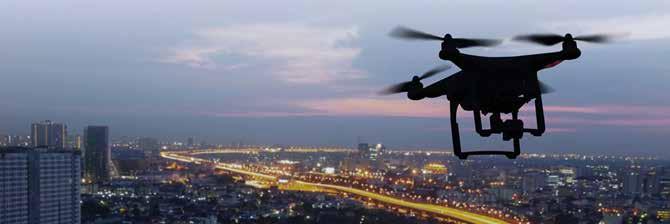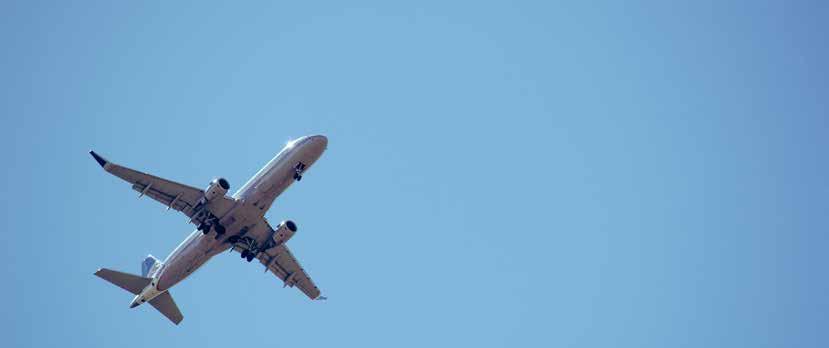
16 minute read
Understanding the airspace implications
Harmonization (Edition 3), provides guidelines for the development of UTM systems on a global scale, which would “enable industry, including manufacturers, service providers and end users, to grow safely and efficiently without disrupting the existing manned aviation system.”
ICAO further provides guidance on how such a system could be developed “through the collaborative integration of humans, information, technology, facilities and services supported by air, ground and/ or space-based communications, navigation and surveillance.” In ICAO’s view, such a system would also achieve “‘continued safety of all air traffic, manned and unmanned; safety of persons on the ground; complex low-level UA operations; ongoing support of technological advancements; evaluation of security and environmental risks; and provision for a global, harmonised framework for low-level UTM.”
Advertisement
However, it is noteworthy that for the time being ICAO guidance focuses on developing UTM as a separate system to the traditional ATM although it is acknowledged that the UTM system should still be “potentially complementary” to traditional ATM systems. Ongoing interoperability with existing ATM systems, ATC frameworks and hardware and the ultimate global harmonisation of UTM are critical overriding features of ICAO’s Common Framework.
The Australian Approach to UTM
Unmanned Aviation list Australia sixth in its recent list of countries making the most progress in UTM systems, and most prepared for drone regulation and applications, as a result of its national UTM flight information management system announced at the start of 2022.
Recent developments in Australia include:
• A National Emerging Aviation Technologies (NEAT)
Policy Statement in May 2021, which sets out “how
Government will support individuals, businesses and industry to adopt new and emerging digital aviation technology…and create an efficient and adaptable operational ecosystem for emerging aviation technologies.”
• The Economic Benefit Analysis of Drones to Australia, published in October 2020, qualifying the “potential economic benefits and savings emerging aviation technologies could have on the Australian economy over the next five, 10- and 20-year periods.”
• The National Aviation Policy Issues Paper on Emerging Aviation Technologies, published in September 2020. This was produced by an Industry Advisory Group convened for the purpose, and which allowed for broader stakeholder consultation. This document informed the NEAT Policy Statement.
Features of National Emerging Aviation Technologies Ecosystem envisioned in the NEAT Policy Statement and/or under development include:
• National drone detection network “to support an increase in drone use incorporating a network of drone detection sensors, linked to a central database, which will filter and produce appropriate data to a wide range of users.”
• Drone rule management system “to coordinate and manage operating rules.”
• Unmanned Traffic Management which “will support the management of a range of risks and impacts associated with emerging aviation technologies, including safety, security, noise, privacy and environmental issues.”
• NEAT Infrastructure Planning Framework comprising
“clear principles and processes to ensure effective and efficient coordination of planning decisions related to construction and operation of eVTOL and drone take-off, delivery and landing sites…in preparation for the future uses of large-scale drones, eVTOL aircraft and AAM services such as air taxis.”
Policy, Coordination, and System Governance (DITRDC) Policy, economic/market regulation, system governance, and regulator coordination
Regulation Setting, Oversight, and Enforcement Safety airspace and system certification (CASA), noise, security, spectrum
UNMANNED TRAFFIC MANAGEMENT (UTM)
Flight Information Management System UTM Service Suppliers
Requests for rules and constraints
CASA Regulatory Services and Registration
Air Traffic Management
Flight information and UTM services
Operational data
Commonwealth, state, territory and local government regulators and law enforcement
Drone activity data
National Drone Detection Network
Detection of noncooperative drone activity
Source: Australian Government (May 2021) ‘National Emerging Aviation Technologies’.
The European Approach to UTM
Of the top 20 countries listed in the Unmanned Aviation report, 12 countries are members of the EU, including Belgium, Poland, Croatia, Austria, Germany, Denmark,
What is U-Space?

Finland, Spain, Netherlands, France, Italy and Ireland.
Most noticeable for the European region, has been the provision for ‘U-Space’ across the member states of the EU under the auspices of the Single European Sky Air Traffic Management Research Joint Undertaking (SESAR-JU).
The U-Space refers to a set of services relying on digital services and automation of functions designed to support safe, secure and efficient access to U-space airspace for a large number of uncrewed aircraft systems (UAS).
U-Space provides a framework to facilitate the implementation of more complex UAS operations in all classes of airspace, while ensuring an orderly coexistence with crewed aviation and Air Traffic Management (ATM).
U-Space also allows for a set of agreements, protocols, means of communication and standards that together must ensure that the growth of uncrewed air traffic will proceed in an orderly manner in the future including more complex operations.
Through a clearly documented staged process, U-space will ultimately be capable of ensuring the smooth operation of drones in all operating environments, and in all types of airspace (in particular, but not limited to, very low level airspace.) It addresses the needs to support all types of missions and may concern all drone users and categories of drones.
Fundamental building blocks for U-Space include: network identification; geo-awareness; air traffic information; and flight authorisation; and is underpinned by a common information service, called the CIS.
Other aspects of U-Space will include:
• States being allowed to designate areas where
U-Space will apply • Provision for U-Space Service Providers (such as
Altitude Angel or Unifly) • Provision for operators to pay subscription fees to fly within designated U-Space areas • Restrictions for crewed aircraft that enter areas of
U-Space
2022 EU UTM TRAFFIC MANAGEMENT SYSTEM
Meteo sensors Spatial data infrastructure
Meteo info Spatial info Real-time positioning Performance info Operation/flight request Contingency info
ATM System
Aeronautical info
3 4
UAS Traffic Management Provider
Situational awareness
Privacy feedback 2
Situational awareness Priority constraints
Conflict advisories Geo fencing Authorisations and directives Notifications/Alert warnings Situational awareness
5
UAS Identification
UAS Registration
2
Public user UAS Registration
Authorities Emergency services Law enforcement
UAS Registration system UAS
Navigation infrastructure
1
UAS Registration UAS Pilot/ Operator
NB. Arrows imply communication infrastructures to support
Adapted from GUTMA Architecture
U-space in action
Skyguide and its project partners will demonstrate U1 & U2 capabilities including:
1 Drone registration – with a blockchain based database managed by
SITAONAIR 2 Authentication
of the drone’s
identity – against the SITAONAIR registration database using AirMap technology 3 Integration
with ATC & digital airspace
authorisation – from skyguide through through the AirMap platform 4 Dynamic flight
plans and live
telemetry – visualised on
AirMap U-space dashboard 5 Real-time drone telemetry data – sent by senseFly
Source: SESAR Joint Undertaking (2017) U-Space Blueprint. Available at: https://www.sesarju.eu/sites/default/files/ documents/reports/U-space%20Blueprint%20brochure%20final.PDF As of July 2022, SESAR-JU is sponsoring the new project, U-Space SEParation in Europe (USEPE), which aims to research and test concepts that will harness, develop and accelerate the adoption of cuttingedge technology to solve the safe and effective management of conventional aircraft, drones, eVTOL and similar vehicles flying at very low level (VLL), as well as at higher altitudes.
The UK Approach to UTM
Although the UK does not feature in the list of top 20 countries identified as making the most progress with UTM architecture and implementation in the Unmanned Aviation Report on global UTM readiness, the report does acknowledge that the UK has more drone/UAM research programmes per head of population than anywhere else. Which of these will deliver the rules and procedures to directly allow imminent automated UTM drone operations in complex airspace has yet to be determined.
Also of note is the UK’s participation in the EU-lead Air Mobility Urban – Large Experimental Demonstrations (supported by SESAR-JU), providing demonstrations at Cranfield University (June and September 2022). During these demonstrations, multiple services were
2022 UK Approach to UTM
tested, such as ‘sat-comm’ capabilities for on-board internet connection, USSP structures and the testing of contingency management and action plans.
The UK has led the way in terms of using UTM to create the first autonomous corridor of over 265km long, and The Airspace of the Future project has started live trials with the UK National Experimentation Corridor (NBEC), with a view to enable drones to transition from VLOS to BVLOS operations by 2030.
The UK has also been developing and testing an Open Access UTM framework, described in a publication produced for the Department of Transport in 2021, to bring the UK a step closer to enabling commercial UTM operations within its airspace, and function as the starting point for future UTM initiatives that will enable projects including those funded via the Future Flight Challenge.
CAA Public Authorities
UTM process oversight Dynamic airspace management
Relevant Airspace Activity Information
ANSP Services
Amalgamation of datasources and the relevant services to provide data consistency and integrity across the UTM network
OPEN UTM SERVICE
Service authorisation
Supplementary Data Service Provider Open Service Provider
Local UTM Network
Insurance Weather Connectivity; etc Telemetry: Operating Notification; Guidance Information
Licenced UAS Operator
Relevant Airspace Activity, Permissions
Operator Registration Vehicle Registration
Airport In
Other ATM/ATC Services
Source: Implementing an Open Access UTM Framework for the UK (2021)

Most notable among key UTM related projects and initiatives funded through the UK’s Research and Innovation’s Future Flight Challenge initiative is Project Skyway.
Project Skyway, which is enabled by a consortium led by UTM solution provider Altitude Angel, alongside telecommunications group BT and various UK tech startups, was given the go-ahead by the UK Government in July 2022. It comprises the world’s largest and longest network of drone superhighways in the UK. The 165mile drone highway will connect Reading, Oxford, Milton Keynes, Cambridge, Coventry, and Rugby, with the option for future expansion to other towns, cities and regions in the UK.
Through Project Skyway, any drone manufacturer will be able to connect a drone’s guidance and communication systems into a virtual superhighway system which takes care of guiding drones safely through ‘corridors’, onward to their destinations, using only a software integration. The Skyway will provide ground sensors to provide real time guidance, which means drones will not be required to carry on board sensors to detect and avoid other air traffic. This in turn means improved payload capacity, range and better guidance and safety.

According to Richard Parker, Altitude Angel CEO and founder, “This system will ensure any company can safely get airborne and build a scalable drone solution to benefit society, businesses, and industry, on level and fair terms, accessible to everyone.”
Source: Altitude Angel (18 July 2022) ‘UK Government gives the green light for World’s longest drone ‘superhighway’”.
The Approach to UTM in the USA
The USA currently holds 18th position in the Unmanned Aviation ranking of UTM readiness. The report specifically notes the final recommendations issued in March 2022 by the Federal Aviation Administration’s UAS BVLOS Aviation Rulemaking Committee (UASBVLOS ARC), which included the need to set up risk targets for all types of drone operations.
The report also notes that, in collaboration with industry and stakeholders, the Federal Aviation Administration (FAA) is planning field tests for new entrants later this year to test UTM safety standards and data exchanges. Although commercial daily BVLOS operations remain constrained in the USA, extensive trials are underway throughout the country, including the highly successful Low Altitude Authorization and Notification Capability (LAANC), and UTM area “bubbles” are emerging, which concentrate complex drone flights in core research areas. However, owing to questions over the revenue potential for UTM service suppliers, key and pioneering UTM services suppliers AirMap and Skyward have exited the market.
According to the FAA website, the current focus of the US approach to UTM, is to collaborate and explore options and concepts with the National Aeronautics and Space Administration (NASA), other federal agencies, academia and industry stakeholders, for managing BVLOS operations below 400 feet above ground in uncontrolled airspace.
In these discussions, the emphasis is on identifying “concepts for operation services, roles and responsibilities, information architecture, data exchange protocols, software functions, infrastructure, and performance requirements for enabling the management of low-altitude uncontrolled drone operations.”
Activities have been underway since 2017, most notably the release of the Concept of Operations (ConOps) for UTM within national airspace, Version 2, in March 2020. This document is an update of the original version published in 2018, and describes foundational principles and components, operations, roles and responsibilities, and operational scenarios. According to the document, the objective of the ConOps is not to “prescribe solutions” but rather to “inform development of solutions across the many actors and stakeholders involved in implementing UTM.”
NASA is also advancing the concept of Advanced Air Mobility (AAM) to enable a “safe, accessible, automated and affordable air transportation system for passengers and cargo capable of serving previously hard-to-reach urban and rural locations.” A National Campaign for AAM was announced by NASA in May 2022, with a view to promoting “public confidence and accelerating the realization of emerging aviation markets for passenger and cargo transportation in urban, suburban, rural, and regional environments.”
What is evident from the picture of the evolution of UTM internationally, as well as from general feedback received from the international professionals interviewed for this paper, is that a number of key challenges and opportunities exist around the development and implementation of international UTM systems.
Risk, uncertainty and paradigm shifts
The paradigm shift from traditional aviation is commonly stated, in one form or another, and is vital to achieving the level of safety, security and efficiency of crewed, uncrewed and automated air traffic management required.
The scale (and impact) of the activities required to adopt and integrate UAS into the existing ATM framework is undoubtedly daunting from multiple perspectives and no easy task given the different pace at which traditional establishments operate, in relation to the rapidly evolving UAS and emerging technologies industry. This is especially the case for the development of the UAM and AAM business case and marketplace.
The degree of uncertainty and risk associated with the scope of innovation required for this new emerging technology driven industry is high. Some concerns that have emerged include uncertainty about the business case for UAS/UTM/UAM and other associated activities, especially in light of safety, budgets, security and public acceptance.
There is also, for example, uncertainty about the capability, robustness and resilience of the technology for achieving the key components of UTM, including communications, detect-and-avoid and counter-UAS.
In addition to these concerns, there is also an inherent irony, as identified by ICAO, that to meet demand, states and regulators are encouraged to be innovative. However, this is leading to a lack of harmonisation that may impact safety, security, the environment, system reliability and economic efficiency. This irony alone creates an uncertainty about being an early adopter (often at considerable expense in time and money) compared to waiting until a final harmonised UTM system has been proven by others.
In contrast to the challenges facing the development of UTM internationally, perhaps the most overriding opportunities, enablers or drivers for establishing a UTM system and supporting emerging aviation technologies lie in recognising the broad applications and value of the UAS industry.
By actively supporting the demand for drone services of all types and scales, nations can achieve a number of things, not least among them being a boost to economic growth in many other industries that may benefit from the application of UAS (including eVTOL) through improved efficiency, better productivity and associated cost and safety conditions.
As evidenced by the Australian approach to UTM, such integration can attract greater investment, create employment, stimulate new business models, foster research and innovation in emerging aviation technologies, create new services for society, and promote economic growth within the aviation sector and across other industries.
The prestige gained from early adoption, innovation and implementation of successful UTM systems may also set a precedent for revolutionising aviation and harmonisation for global air traffic management (crewed and uncrewed).
07
This section explores the evolution of drones and their technical implications within the UTM context. There are five key elements identified, which will influence the success of uncrewed traffic integration: the regulatory ecosystem, the importance of separation and integration, the technology ecosystem and the platform/UAS/inherent technologies.
In the words of economist Adam Thierer, drones were “born in captivity”. Drones are entering skies as newcomers to a world in which crewed aircraft have evolved to become extremely safe. A matured industry with little tolerance for risk can present a challenge for the new entrants.
Drones have distinct features that are fundamentally different from crewed aircraft. Their current and projected future uptake by industry and technical developments are fast, disruptive and almost intimidating. While these technologies are challenging the digital nature and speed of innovation of crewed aviation, they also provide the solution for the incorporation of UTM into the world of traditional air traffic management (ATM).
Within the platform/UAS/inherent technologies are the elements of design, body/airframe (aerodynamics, airframe materials and structure), power supply (energy) and fuel systems, propulsion (propeller, turbine/jet, ramjet, rocket), actuators (servos and flight controllers), software and sensors. Next are the airspace and traffic ancillary technologies, including spectrum and remote real-time identification and tracking, addressing the current use of ADS-B transponders. Last is the ground footprint and management of ancillary technologies, including ADS-B receivers, data storage/cloud computing services, AI/ computational modelling and simulation, surveillance systems, airspace security and cyber security.
The adoption and integration of drone technology into the crewed aircraft world will only happen through a process of testing existing and developing technologies in a safe environment cloned as drone hubs and drone corridors. These proof of concept endeavours must support all possible drone applications and use cases, and the development of a roadmap applying a riskbased approach to identify the location of future drone hubs and corridors is required.
There are two critical areas where drones impacts aviation, namely the regulatory ecosystem and the technical ecosystem, both equally informing the UTM domain, which is a requirement to unlock the power of drones. 5 Key Components for Successful Uncrewed Traffic Integration
Status Stakeholders
Remote ID Currently under development Drone Manufacturers; Regulators
Stakeholder Buy-In In an early phase Drone Operators, Regulators, Civil Aviation
Regulations Under development SACAA, Int’l Standards Bodies
Communication
Software Early adoption phase Network Providers, Drone Manufacturers
Under development with partial adoption Software developers and ecosystem members
Key Challenges
Standardisation; practical adoption barriers
Diverse needs in the ecosystem and differing levels of drone knowledge
Catching up to rapidly evolving technologies
Network coverage, potential high usage, ensuring connectivity Regulatory approval, connectivity; widespread adoption, evolving technologies
Source: McNabb, M. (20 May 2020) ‘DRONEII: The 5 Key Components of Successful Unmanned Traffic Integration’, DRONELIFE.
The regulatory ecosystem
A new model will be required to allow for integration with existing ATM with a delegation of responsibility for traditional air navigation services, from a single supplier to multiple operators operating in a distributed fashion.
What will be needed are new systems with high levels of digital technology (automation and connectivity) that will allow for and raise new challenges related to: • Data links – frequency spectrum, allocation and usage, resilience and cybersecurity. • Cloud-based networking of information – using
System Wide Information Management (SWIM) technology, allowing for data collection, processing and sharing.
The graphical presentation of a generic UTM value chain, below, highlights the interaction of the various events:
A proposed seven step UTM value chain (breakdown of support services)
Vehicle performance database
UTM Vehicles Registration
Check static constraints Check dynamic constraints
3
4
Dynamic Constraints Weather, Conflict Detection, Feasibility
Check if UVIN is registered
Schedule delivery to…
1 2
UAS Support Services
5
6
Share information
Operator submits operation (waypoints; vehicle info; operator data)
UAS Operator function ANSP function 7
UAS Traffic Management UTM
Contingency Management Geo-fence breach, Loss of C2, Emergency responder, Operation completed
Operation complete
Source: Parimal Kopardekar et al. (June 2016) ‘Unmanned Aircraft System Traffic Management (UTM) Concept of Operations’.




